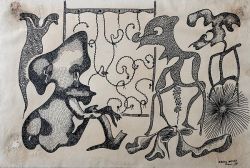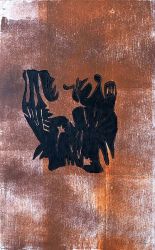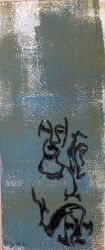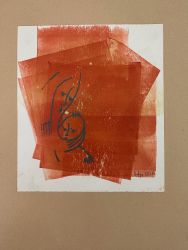Uche Okeke
Painter and printmaker, from Nigeria
Okeke took a minimalist approach, eschewing the superfluous without loss in composition and meaning. This investment in line is characteristic of his work of the first half of the 1960s, an experimental phase in which, seeking to establish an original language, he also worked in a range of mediums, including oil, ink, linocut, and others.
Okeke considered drawing fundamental to the creative process. It also offered him the closest approximation of uli, the graceful linear mark-making practiced by Igbo women in traditional settings, adorning the body for beauty or the walls as murals. Okeke’s mother drew uli designs when he was growing up. Now a dying tradition, uli captures the essence of a line that gives form to a void.
Christopher Uchefuna Okeke was born on 30 April 1933 in Nimo, Njikoka Local Government Area of Anambra State, Nigeria, to Isaac Okonkwo Okeke and Monica Mgboye Okeke (née Okoye). Between 1940 and 1953, he attended St. Peter Claver's (Primary) School, [Kafanchan], Metropolitan College, [Onitsha], and Bishop Shanahan College, Orlu, Nigeria, during which time he had already begun to demonstrate an avid interest in drawing and painting. Before being admitted to read Fine Art at Nigerian College of Arts, Science and Technology (NCAST), now Ahmadu Bello University, Zaria, Okeke had already exhibited taxidermy work during the Field Society meeting in Jos Museum, participated in the preparation and presentation of Nigerian Drawings and Paintings with Bernard Fagg as curator and had a solo exhibition of drawings and paintings, in Jos and Kaduna with Sir Ahmadu Bello in attendance.[1]
Zaria Art Society
As a young artist, Okeke was a founding member of the Zaria Art Society in 1958. The group was a result of political conflict in Nigeria struggling to gain independence and was founded by important protagonists of modernism in Nigerian Art like Yusuf Grillo, Bruce Onobrakpeya, Oseloka Osadebe, Demas Nwoko and others. Most of his professors at the Nigerian College were British and taught western style techniques however, The Zaria Society opposed the imposition of European art school ideas on young artists in Africa. In school, Okeke studied the Igbo, Yoruba, and Hausa ethnic groups, looking for a way to express his Nigerian self. Ancient Nigerian symbols are most commonly found on pottery or in body paintings. Igbo designs are called Uli Patterns.[2]
Nsukka
In 1971 Uche Okoke joined the Departement of Fine und Applied Arts at the University of Nigeria in Nsukka as a Professor and teacher. Together with colleagues and students he developed a unique style which became characteristic for the so called Nsukka School. With Chike Aniakor and Obiora Udechukwu he established the formation of art and aesthetics of Nigerian modernism in the seventies.[3]
Igbo Culture and Design
Okeke was first exposed to Igbo folktales as a child and later used them as inspiration in his art. In some of his drawings, the artist rendered the heroic mythological figures to bring attention to his Igbo heritage.[4]
(click images below to view artworks)



